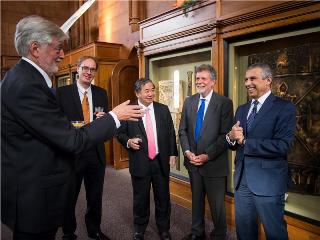Mar 19 2015
Nanyang Technological University, Singapore (NTU Singapore) has partnered the Smithsonian Institution, the world’s largest museum and research complex based in the United States, to advance research in tropical ecology.
 NTU Provost Professor Freddy Boey (centre) and Smithsonian’s Interim Under Secretary for Science Dr W. John Kress (2nd from right) at the Smithsonian’s Castle in Washington, D.C, United States, with His Excellency Ashok Kumar Mirpuri, Singapore’s Ambassador to the USA (right). Professor Alexander Zehnder, member of the NTU Board of Trustees (left) and Prof Stephan Schuster (2nd from left), also attended the MOU signing ceremony.
NTU Provost Professor Freddy Boey (centre) and Smithsonian’s Interim Under Secretary for Science Dr W. John Kress (2nd from right) at the Smithsonian’s Castle in Washington, D.C, United States, with His Excellency Ashok Kumar Mirpuri, Singapore’s Ambassador to the USA (right). Professor Alexander Zehnder, member of the NTU Board of Trustees (left) and Prof Stephan Schuster (2nd from left), also attended the MOU signing ceremony.
The two institutions signed a Memorandum of Understanding (MOU) today to collaborate on educational and research efforts in the areas of tropical forest, marine ecology and environmental change in Asia.
The joint research and educational collaboration will be focused on areas such as biodiversity, forest and marine ecology, climate change, human-environment interactions and genomics.
This is the Smithsonian Institution’s first formal research agreement in Asia, and NTU will be established as the Asian scientific hub for the Smithsonian’s Forest Global Earth Observatories programme (ForestGEO).
ForestGEO is a global network of more than 60 tropical and temperate forest plots in 24 countries where scientists examine forest function and diversity. It is part of the Smithsonian’s Global Earth Observatories programmes, which also includes MarineGEO, the first long-term, worldwide research programme with seven sites to focus on understanding coastal marine life and its role in maintaining resilient ecosystems around the world.
This landmark MOU was signed today by NTU Provost Professor Freddy Boey and Smithsonian’s Interim Under Secretary for Science John Kress at the Smithsonian’s Castle in Washington, D.C, United States. His Excellency Ashok Kumar Mirpuri, Singapore’s Ambassador to the USA graced the event as the Guest-of-Honour.
NTU’s new Asian School of the Environment will be the main partner to the Smithsonian Institution, supported by the university’s premier research centres - the Earth Observatory of Singapore (EOS), the Singapore Centre on Environmental Life Sciences Engineering (SCELSE) and NTU’s Complexity Institute.
Professor Freddy Boey said the partnership with the Smithsonian Institution is a milestone for Singapore and a testament to NTU’s world-class research capabilities.
“NTU’s partnership with the world-renowned Smithsonian Institution is testament to the high quality and impactful research that we are known for, especially in the area of sustainability and earth science where we have made great strides over the past five years.”
“Together with the Smithsonian Institution, our combined research efforts will be instrumental in advancing forest and marine ecological science, to better understand nature and the world around us. The discovery of such knowledge will allow scientists to tackle the huge challenges we have today, such as climate change and environmental degradation.”
The signatory from Smithsonian Institution, Dr. W. John Kress, the Interim Under Secretary for Science, said: “The partnership with NTU will greatly benefit our Global Earth Observatories initiative and open new avenues for Smithsonian scientists in Asia. Together, NTU and Smithsonian scientists will make discoveries that neither could accomplish alone.”
A joint professorship between the two organisations will also be set up, housed at NTU’s Asian School of the Environment. A world-class scientist well-versed in the area of tropical terrestrial ecology will be appointed, who will also act as a conduit and coordinate research projects between NTU and Smithsonian Institution.
Professor Alexander Zehnder, member of the NTU Board of Trustees, who was instrumental in sealing the partnership between the university and the Smithsonian Institution, said: “The quest for sustainability is even more crucial today than ever, given the rapid climate change fuelled by the world’s population boom.”
“Both NTU and the Smithsonian Institution share the same vision that many of the answers to climate change issues can be found in the tropical Asia region. Starting with forest ecology and science, the research will be beneficial in designing sustainable strategies, which will play an important role in the survival of mankind.”
Associate Professor Charles Martin Rubin, Chair of the Asian School of Environment, said that together with the Smithsonian Institution, the school wants to train more manpower for environmental science for the Asian region.
“We are looking to educate and train both top notch scientists and also students, to better understand the environment in the Asian tropical region which is not that well studied yet.
“We want to train researchers in the natural sciences to pay attention to the interaction between societies and the environment, and ways to promote adaptive governance of social-ecological systems.”
Professor John Stephen Lansing, co-director of NTU’s Complexity Institute and a professor in the Asian School of Environment said, “The tropics are home to about 80 per cent of the world’s terrestrial biodiversity.
“Just to the south of Singapore is the Coral Triangle, and most of the world’s marine biodiversity. These are the crown jewels of our planet. Half of the world’s children live in the tropics, and that number is projected to rise to two-thirds by the middle of the century. But the future is a time that we can change.
“We need to find solutions to problems like deforestation, which is already beginning to affect our air quality in Singapore. Deforestation also leads to habitat loss for wild animals, triggering the spread of new infectious diseases from animals to humans.”
Some of NTU Singapore's ambitious environmental science projects include the establishment of observation sites at the Sumatra subduction zone for seismic activity, the study of biofilms in urban waterways, the building of a comprehensive global oceanographic database and the sequencing of air microbiodome.